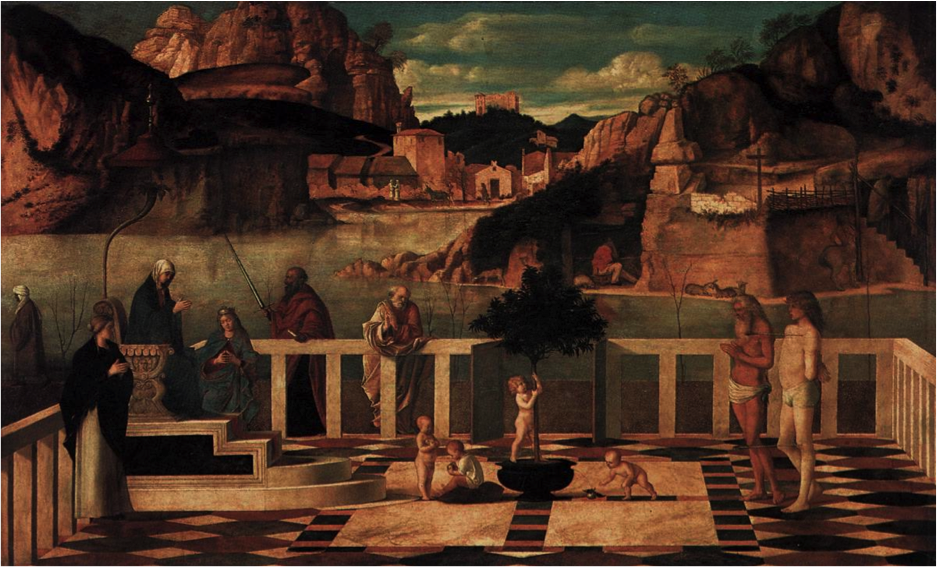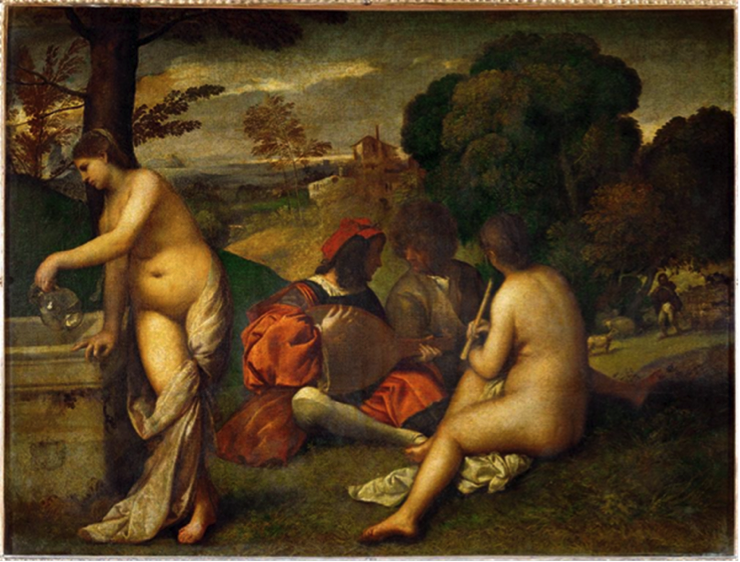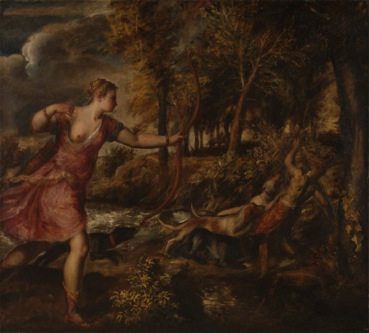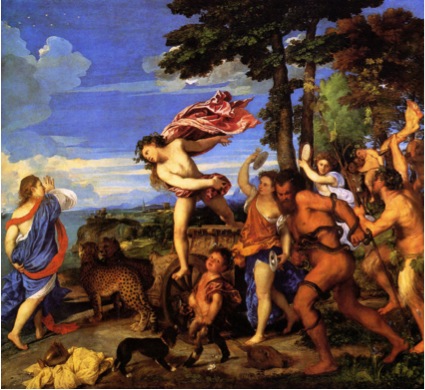| Jul/Aug 2014 • Miscellaneous |
| Jul/Aug 2014 • Miscellaneous |
In Ars Poetica, the ancient poet Horace (65 BC - 8 AD) introduced the idea of ut pictura poesis—"as in painting, so in poetry."(1) Aristotle and Plato discussed the relationship between text and image long before, but it was Horace who popularized the idea of painting and poetry entering into a conversation with, and about, one another.
Venetian poesie paintings owe a great debt to the poets and painters of antiquity, whose palettes they smoothed onto their canvases and panels in new and brilliant ways. The Greek origin of the word ekphrasis is ekphrasis, but it carries a different meaning: to recount or to describe.(2) Put simply, the act of ekphrasis involves describing a work of art—recounting its story. Alberti's Della Pittura, according to Rensselaer W. Lee, was "the fountainhead of all Renaissance art." Alberti encouraged Renaissance painters to "associate with men of letters, poets and orators, through whom he might be introduced to the literary culture of antiquity."(3) In relative isolation in northeast Italy, Venetians developed a unique conversation with literature and artwork of the distant past, collaborating on projects spanning hundreds of years.
Plato, predating Horace and his ut pictura poesie by hundreds of years, concluded that "the real artist... would be interested in realities, not imitations."(4) His theory of forms is elucidated by the idea of "bedness": a god-like being creates a perfect idea of a bed, a carpenter creates a three-dimensional copy of the idea, and the artist creates an imitation of the carpenter's imitation, which is twice removed from the truth of the ideal bed. In his sweeping denigration of art as artifice, Plato paves the way for Aristotle's pendulate shift from asceticism to aestheticism that no doubt influenced Aristotle's more ekphrasis-friendly The Poetics: "Imitation is natural to man from childhood... And it is also natural for all to delight in works of imitation." It is easy to trace Horace's maxim Ut pictura poesies back to Aristotle's Poetics.(5)
I'll be focusing on two types of poesie paintings that were birthed of ekphrasis: the pastoral and the mythological: Bellini's "Sacred Allegory," Georgione's (or Titian's) "Pastoral Symphony," Titian's "Death of Actaeon," and lastly, "Bacchus and Ariadne"—a Titian encore.
Conservative appraisals of ekphrasis's usefulness straddled the Renaissance; Plato's stern remonstrances(6) 500 years beforehand, and Lessing's a couple hundred years after. Between them, a liberal, and literal, orgy of the senses rioted in Venice beneath the brushes of Bellini, Titian, and Giorgione—an ambidextrous synaesthesia that blurred the lines between poets and painters and gave birth to "poesie" paintings that did not emulate poetry, as such, but interpreted and embellished it.

Fig 1. Bellini: Sacred Allegory. c.1490-1500. Oil and tempera on panel, 73x119
cm. Galleria degli Uffizi, Florence, Italy
Bellini is often credited with having started the "poesie" movement with "Sacred Allegory,"(7) an enigmatic painting whose meaning has puzzled art historians for years; they are no closer to a concensus as they were 500 years ago. The tree is the tree of life, says one. Another is certain it's the tree of knowledge. And so forth. Depending upon which article one reads,"Sacred Allegory" is an interpretation of a 14th century poem, a moral allegory, or a representation of the garden of Eden.(8) This ambiguity—the raw material of many poesie paintings—allows a democratic experience of the painting—each viewer can interpret the painting in a personal way and feel certain he or she is correct. Indeed, the painting seems to invite our participation; the balustrade that should gate the picture off from our reach is actually, by a wonder of perspective, located behind us.(9) We have become a part of the painting just by looking at it.
Painted between 1490-1500 on the cusp of the high Renaissance, it maintains a bit of the stiffness and crowdedness one expects in a quttrocento painting but introduces a new mood: that of introspection and contemplation. The figures do not seem to notice one another or to share a narrative. Though in proximity to one another, they remain alone and senseless, like figurines on a table. Ironically, the huddled figure in the cave on the opposite side of the lake seems no more alone than the crowd of people on the deck. The figures inhabit the space but are not fully present—their attention seems to be focused on prayer or on invisible companions, as if each has been plucked out of a more seemly setting and placed arbitrarily into Bellini's surreal tableaux.
According to Norman Land, in his "On the Poetry of Giovanni Bellini's Sacred Allegory," the painting is populated with Biblical figures. Job, hands in prayer, stares at the sacred tree. St. Sebastian, hands behind him, white flesh pierced by two arrows, also stares at it. Mary, seated on a throne, looks at the tree as well. St. Peter is on the other side of the ballustrade, near the lake, also staring. The tree is the focal point of the painting's inhabitants, the loci of their shared hypnosis. Though most hands are raised in steeples of prayer, St. Paul raises a sword and looks in the opposite direction. There is no clear purpose to the motley social gathering on Bellini's starched and structured stage save for their gazes which they hang reverently like fruits on the enigmatic tree.
Bellini claimed that "he did not like to have many written instructions about subject-matter when he painted a picture. Rather, as he said, he 'always liked to wander at will in his paintings...' In this panel... we are contemplating a fantasia, the product of a mind wandering freely at will."(10) Arcadian scenes, then, aren't as pescriptive as mythological ones might be; they allow the mind to wander and express its phantasie—its imagination.
"Sacred Allegory" boasts a Renaissance vocabulary; Biblical figures, cherubs, saints, a pastoral landscape in the background. The three patches of verdant vegetation, beginning with the tree, echo one another in a straight line from mid-foreground to background. They share a sympathy and uniformity that leads the eye to the idyll of nature. "Sacred Allegory's" ambiguity and otherworldliness is reminiscent of a dream state; the viewer is disoriented by the social tension and random iconography, yet soothed by the solid lines, held up by the balustrade, and reassured by the rationality of mathematically engineered tiles beneath our feet. Just as in a poem, disorientation spurs us to find a foothold—and we do, in the comfort of our own interpretations. In effect we finish the poem with the most powerful tool we have on hand as observers: our imaginations, with which we perform our own ekphrasis as a way of achieving clarity, as one might try to focus one's eyes on a blurry object. Similar to the poems of this period—villanelles, sestinas—our swoon takes place within the orderly, predictable lines of stanzas and scaffolds, ballads and ballustrades. It is safe to swoon here.
Bellini is known for his creative bricolage of classical architectural forms—a patchworked homage to antiquity that successfully conjures feelings of dreaminess and otherness. Antiquities posed a unique challenge for Venetians like Bellini, who, unlike the Romans and Florentines, had very little exposure to ruins and excavated sculpture.(11) Thankfully Pliny and other writers provided detailed accounts of excavations and sculpture: the Laocoon, the Hercules, the great torso of Belvedere.(12) Their accounts and sketches gave Venetian artists a dictionary of forms to emulate.(13) "The earliest examples of ekphrasis involve Appeles and Zeuxis"(14) —ancient master painters immortalized in Pliny's Naturalis Historia. Zeuxis is said to have painted Aphrodite, for example, in the 5th century BC.(15) "The 'Calumny' of Apelles, the picture by which the ancient painter [Appeles] had defended himself against vicious slander, became the classical subject par excellence; through it painters... would declare their classical pedigree."(16)

Fig. 2. Giorgione (or Titian): Pastoral Symphony. c. 1510-11. Oil on canvas.
105 x 136.5 cm. Musée du Louvre, Paris, France.
Though the attribution is not certain, "Pastoral Symphony" exudes the atmospheric, laconic mood of a Giorgione. A student of Bellini, Giorgione has embraced the pastoral idyll that served as a mere backdrop to Bellini's"Sacred Allegory" just ten years prior; landscapes were considered wallpaper for the backgrounds of painting, but by no means worthy subjects the paintings themselves. In "Pastoral Symphony," the arcadian theme has come fully into its own, in a vignette that gives equal stature to human relationships as to their relationship with nature.
On the heels of the plague, Venetians synthesized an idealized world of contemplation and poetic harmony with nature. Arcadia is never here and now; like any Elysium, it is always just out of reach, in the realm of afterlife or fantasy. And that's what they called their atmospheric paintings: phantasies, a word that means both fantasy and imagination. According to the National Gallery Catalogue, "Arcadia was a mythical rural realm ruled by the god Pan. It was first written about by the Greek poet Theocritus in his 'Idylls' of the 3rd century BC."(17) Pastoral "Arcadian" paintings were also very much inspired by stories such as Colonna's Hypnerotomachia Poliphili, Boccacchio's Ameto and Genealogia deorum gentilium, Virgil's Ecologues, and Sannazaro's Arcadia. Sannazaro "was the first Renaissance poet to set his action in Virgil's hallowed Arcadia. More important, he paid tribute to the continuing effect of Virgil's ecologues upon the Renaissance imagination by transforming Latin Arcadia to suit the highly developed taste of contemporary Italian verse. This imaginary region, which was supposed to be suffused with romance, formed the context for much Renaissance pastoral poetry, drama, and later painting."(18) Hypnerotomachia Poliphili: Strife of love in a Dream was published just ten years before "Pastoral Symphony" was finished. It is possible that Bellini, Giorgione, and Titian had read this and were influenced by its dreamy approach and "poetic inspiration."(19) Pastoral poesie paintings, then, strove to capture the mood and temperament of antiquity, rather than to narrate a specific myth.
Similar to Bellini's Sacred Allegory, the figures in "Pastoral Symphony" seem oblivious to one another. Only the men acknowledge one another; they do not acknowledge the nymphs, and neither do the nymphs enter into a narrative with them. We can assume that the nymphs are the men's imaginary muses because the weather would not be hospitable to nakedness. The copper trees divulge the presence of autumn, yet despite the inevitable chill in the air, these women are naked. Only in the men's imaginations can the leaves be turning and the weather still be warm enough to warrant nudity. The men's dress is not anachronistic as one might expect in an arcadian painting—they wear everyday Renaissance clothing instead of togas. Georgione's nod to antiquity is achieved, instead, by the men's laconic gazes and the dreamy tenor of the painting. As with Bellini, the gaze is directed inward. If we look closely, we expect to see the eyes glassed over in reverie.
Reverie is the key to this painted poem. It seems to be fading like a photograph, the sepia tone overtaking not only the foliage, but also the flesh. Autumn seems to be dissembling the entire scene. The painted surface appears to be scrubbed. Fine details have disappeared, leaving the painting mute; a silence plucked on the missing strings of the lyre. The musician is playing imaginary music. The nymph points her silent flute at the ruse, doubling the silence. The nymphs' skin, too, seems as worn away and semi-transparent as the man's face on the right. His features are barely recognizable. He is anonymous. Perhaps that is part of the lure, one of the reasons why pastoral poems such as these lined the walls of wealthy Venetian homes. They reminded conniseurs of a simpler time in their youth, or in antiquity. Of life's simpler pleasures. The paintings promised escape, anonymity, privacy. A suspension of time and identity in a protective and protracted glade; the nymph's water jug will never empty, winter will never arrive, the nymphs will never age, and the music will never stop playing in their imaginations.

Fig. 3. Titian: Death of Actaeon. c. 1559-75. Oil on canvas. 178.8 x 197.8
cm. National Gallery, London, UK
Titian painted six "poesies" for Philip II involving mythological dramas and the female nude. In "Death of Actaeon," Titian has taken artistic license with Ovid's poem, changing the narrative but remaining true to the vindictive mood. And license is the key word here: in Ovid's version, Actaeon happened upon Diana bathing nude in the forest with her entourage of nymphs. Instead of backing away, he filled his eyes with her body. He took license, veered off the path and chose his own way of ending his story. Titian is faithful to the spirit of the poem for straying from its particulars; namely, Diana shooting him with a stream of arrows instead of a stream of bathing water. This is the beauty of ekphrasis; it gives stories to many synaesthetic voices across the arts and is an evolutionary product of oral storytelling, wherein each storyteller adds his or her own thumbprint to the communal narrative. An artist's steadfastness to the originial need not be absolute; the National Gallery's website, on their "Death of Actaeon" page, provides a link to the Ted Hughes version of Ovid's poem, from Hughes's lush and swaggering Tales from Ovid which strays wildly from Ovid's original, much like Actaeon straying from the path. Luckily for us, Hughes's virtuosity, and Titian's, are allowed such latitude.
The 18th century art historian Lessing, in his treatise on the relationship between art and poetry, Laocoon, posits that "poetry and painting should not be confused" and explains that erroneous criticism "has produced the love of description in poetry, and of allegory in painting." He felt expectations were off the mark: "...critics strove to reduce poetry to a speaking painting... and painting to a dumb poem."(20) Lessing's view is more in keeping with Plato's belief that art and poetry should remain distinct disciplines, not imitations of imitations. "Death of Acteon" contests Lessing's claim; the canvas is not mute or unintelligible as narrative. It conveys the poem's energy and anger in manifold ways. The brush strokes have a rushed, sketch-like quality which render Actaeon and the hounds as mere characatures compared to the suppleness and three-dimensionality of Diana's arresting body. Our eyes are drawn to her. She is the only fully realized being in the image. Even her dress is an afterthought, it seems, its impatient strokes failing to capture the drape or movement of fabric. Everything is an approximation here except for Diana's nakedness, which is real. Moving on from the strokes to the colors, the atmosphere is fraught with pathetic fallacy, Diana's rage played out among the clouds and storm-swept trees which frame Actaeon's tragedy in a grave of shadow.

Fig. 4. Titian: Bacchus and Ariadne. c. 1520-23. Oil on canvas. 176.5 cm x 191 cm.
National Gallery, London, UK.
In Titian's "Bacchus and Ariadne," we find Ariadne stranded on an island by her love Theseus, who has sailed off without her. Titian was no doubt inspired by Catallus's "Poem #64," which lends narrative voice to the woven figures on the marriage coverlet of the ancient lovers Peleus and Thetis."(21) Titian's painting brims with movement, song, and tides; a current that draws the action into itself from right to left. Theseus's boat steers off the left edge of the canvas, while Bacchus and his throng roll onto the shore from right to left in a wave. But this painting also illustrates time: Ariadne is still reaching out to Theseus even as she is gazing at Bacchus. One foot points to the ocean, the other points to Bacchus, as his foot points to her. She is split; walking in two directions, saying goodbye and hello in an instant. She is a satellite of the blue sky and the sea. Through its woven rivulets on her body, the sympathetic ocean beckons Ariadne into its depths of aquamarine.
Catallus describes Ariadne as wearing a bright sash of anger around her body, a sash that flows in and out of the heart into which "Venus has sewn nettles."(22) Here Ariadne's anger bleeds around her body like a vessel that throbs to the paw of the tiger. She stands bleeding between two other vessels: Theseus's ship that left her for dead, and a golden chalice of drunkenness. Bacchus has heard her appeal for retribution. Through the stitched fibers of the coverlet in Catallus's poem, through her lovelorn letter to Theseus in Ovid's Heroides, Ariadne's voice cries out and Bacchus storms a hasty rescue, at which point Titian holds his caped body aloft with a paintbrush, suspending this moment in time.
The creative act of ekphrasis embodies Ovid's theme of Metamorphosis and parlays his poetry into the world of form and color. In "Death of Actaeon," Titian interpreted Ovid, and later, Ovid was interpreted by Hughes. The idea of ut pittura poesis is inverted in Catallus's poem of an embroidered coverlet upon which myths come to life in embroidery's retelling—as in poetry, so in painting. Titian, in his "Bacchus and Ariadne," illustrated Ariadne's denouement, recreating the coverlet from Catallus's poem with paint instead of thread. Here the paintbrush weaves its bristles into the canvas, and the coverlet is written with descriptions of flora, fauna, and all Ovidian permutations in between. Ovid's imagination runs rampant through Renaissance canvases like Bacchus's wild winding retinue. All Renaissance painters seem to have change on their minds; the Renaissance itself mimicked Ovid's Metamorphoses, dragging the middle ages to the doorstep of the Baroque. These morphing canvases became cameos of high mythological pathos. With one hand Venetian artists painted dreams, with the other, nightmares—a man turned into a stag, a woman turned into a tree; a rape, a heartache. One canvas bleeds and its sister is there to daub it with laconic reverie. Venetian poesie paintings—both mythological and pastoral—do not emulate poetry; they embody it with a parallel language sympathetic to, but not dictated by, the poetic virtuosos of antiquity.
(1) Lee, Rensselaer W. "Ut Pictura Poesis: The Humanistic Theory of Painting," The Art Bulletin, 22.4 (Dec., 1940) 197-269 (http://www.jstor.org) [accessed on 18 November, 2013].
(2) Merriam Webster dictionary entry: ekphrasis.
(3) Lee, Rensselaer W. "Ut Pictura Poesis: The Humanistic Theory of Painting," The Art Bulletin, 22.4 (Dec., 1940) 197-269 (http://www.jstor.org) [accessed on 18 November, 2013].
(4) Waterfield, Robin. Plato: Republic. New York: Oxford UP, 1994.
(5) Aristotle, Poetics. 350 B.C.E, Trans. S. H. Butcher. The Internet classics archive. (http://classics.mit.edu/) [accessed 1 December, 2013].
(6) Waterfield, Robin. Plato: Republic. New York: Oxford UP, 1994. Print.
(7) Land, Norman E. "On the Poetry of Giovanni Bellini's 'Sacred Allegory,'" Artibus et Historiae, 5:10, (1984), 61-66.
(8) ibid
(9) ibid
(10) Land, "On the Poetry of Giovanni Bellini's 'Sacred Allegory,'" 61-66.
(11) Haskell, Francis. Taste and the Antique: The Lure of Classical Sculpture, 1500-1900, Yale University Press, New Haven & London, 1981.
(12) Acton, October 22, 2013.
(13) Acton, October 22, 2013.
(14) Vasari, Giorgio. Lives of the Painters, Sculptors, and Architects. 5th printing. Translated by Gaston du C. De Vere. (New York, London, Toronto: Everyman's Library, Alfred A. Knopf, 1996)
(15) Pliny, and Eugenie Strong. The Elder Pliny's Chapters on the History of Art. (Chicago: Argonaut, 1968)
(16) Lee, 'Ut Pictura Poesis' 197-269.
(17) "National Gallery Glossary: Arcadia." Web. [accessed 27 October 2013]
(18) Kalstone, David. 1963. "The Transformation of Arcadia: Sannazaro and Sir Philip Sidney." Comparative Literature (15.3): 234-49 (http://www.jstor.org) [accessed 1 October 2013]
(19) Acton, Mary. October 22, 2013. "Venice: Bellini and Titian." Lecture notes. Oxford: Diploma in the History of Art, Oxford University.
(20) Gotthold Ephraim, "Lessing — 'Laocoon: An Essay on the Limits of Painting and Poetry,'" (Johns Hopkins University Press, 1 Feb 1984).
(21) Lee, 'Ut Pictura Poesis' 197-269.
(22) Catallus, The Poems of Catallus, translated by Guy Lee. (Oxford, New York: Oxford University Press, 1990).